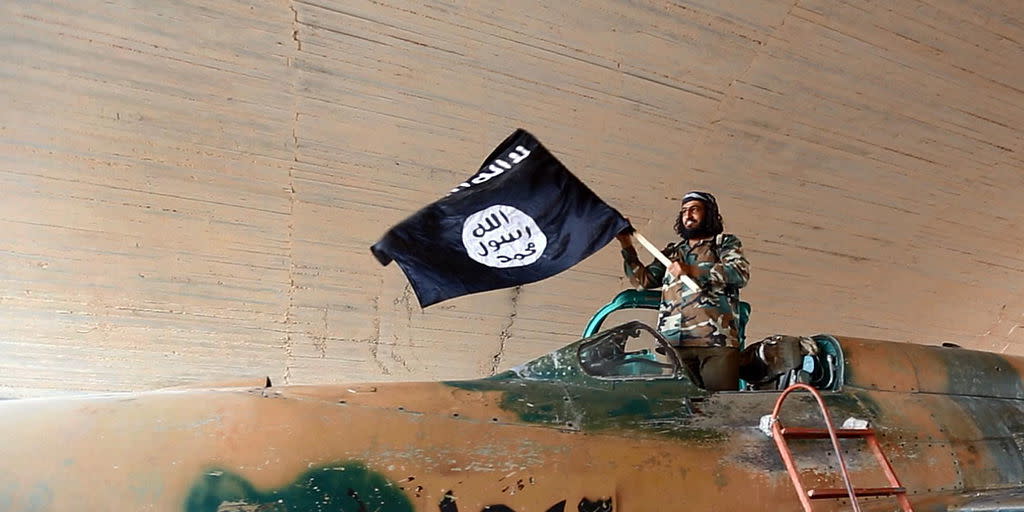Iraqi Officials Find Strange Collection of Makeshift ISIS Drones

After last December's discovery that ISIS have started using explosive-carrying drones in Iraq and Syria, more and more attacks have followed. Now, new finds in the battle-torn city of Mosul have revealed even more details about the terrorist group's attempts to build their own makeshift Air Force.
Last week, Iraqi forces uncovered another ISIS drone workshop in Mosul. This makeshift aerial discovery included a mixture of homemade planes and commercial drones. But the weirdest creation was an ISIS fixed-wing drone with a Phantom quadrotor attached to it. No one knows exactly why ISIS made a drone like this. Is the aircraft supposed to act as a mothership for the quadrotor, releasing it into the target area? Or is the plan to use the aircraft to drop booby-trapped quadrotors, like the one that killed soldiers in Iraq?
Iraqi army found a base in Mosul where Isis used to weaponise drones pic.twitter.com/sZFMjK2vhc
- Hassan Hassan (@hxhassan) November 26, 2016
Lieutenant General Abdul Wahab al-Saidi of Iraq's U.S.-trained Counter Terrorism Service told Reuters that ISIS surveils with drones and "sometimes attaches explosives to them and uses to target commanders or headquarters," but al-Saidi did not indicate whether any of these attacks had been successful. This sounds like an echo of the U.S. Switchblade lethal drone, which was developed for use against 'high value targets'-generally insurgent commanders. There have been several pictures of captured Switchblades in Iraq and Syria, and there are unconfirmed reports that the design has been copied.
In another development, a refugee camp in Syria has been attacked by what look like homemade miniature guided bombs dropped from drones. Details are scarce, but pictures published on Twitter show a number of devices carrying grenade-sized warheads.
The bombs have hand-painted numbers on them, and some of the components show a honeycomb structure which could mean they were 3D printed. If so, then insurgents may be able to share their designs over the internet and newcomers can print their own guided bomb without any experience. It's essentially a lethal step up from 3D-printed guns.
#PT More pics of unidentified device that hit Kafr Hom IDP camp near Turkish border. No engine, honeycomb structure, hand painted SN. pic.twitter.com/6EO5FA17Hw
- Green lemon (@green_lemonnn) November 16, 2016
All of this news comes in addition to an already strange drone discovery in February, when the group Conflict Armament Research inspected an ISIS workshop in Ramadi, Iraq, and found several large drones built from scratch from plywood, Styrofoam, and extruded polystyrene. They also discovered disassembled components from a shoulder-launched Strela surface-to-air missile, which indicated that ISIS were attempting to fit the missile's warhead to a drone, presumably as an anti-helicopter weapon. The three-pound warhead would be too big for the Phantom quadrotor drones that ISIS uses for reconnaissance (and occasionally for carrying explosives), hence the bigger fixed-wing drones with its larger 10-foot wingspan.
Drone delivery has a few advantages over just firing a Strela missile like normal. For one, there is no rocket exhaust, so the launch position can't be spotted. Also a drone will not set off helicopters' missile warning receivers and can't be decoyed away from its target by infrared flares.
We're still in the early days of terrorist drones. But similar to IEDs in Iraq, evolution is rapid. Jammers and other countermeasures are now being shipped out urgently to protect U.S. forces, and the U.S. Army's latest tactical manual includes a section on dealing with this growing drone threat.
As drones and drone countermeasures vie for supremacy, the next move is anyone's guess.
You Might Also Like

